Floral garden extracts create lasting signature scents because they're packed with concentrated essential oils that release their fragrances gradually over time. When you combine these natural compounds through techniques like steam distillation and cold pressing, you'll capture the complex molecular structures that make each scent unique. By understanding proper ratios and layering methods, you can craft enduring fragrances that tell your own aromatic story. The ancient wisdom of botanical blending holds even more secrets to revealing nature's perfumery.
The Historical Roots of Garden-Inspired Fragrances
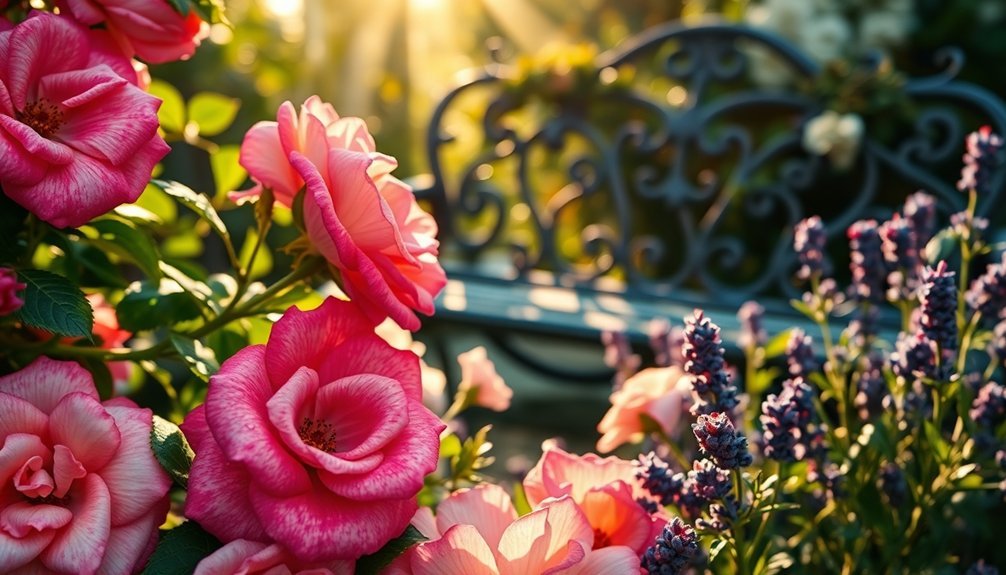
While modern perfumery draws inspiration from countless sources, the practice of extracting fragrances from gardens traces back to humanity's earliest civilizations.
The most famous ancient garden dedicated to fragrance was the Hanging Gardens of Babylon, created as a fragrant paradise for King Nebuchadnezzar II's wife.
You can find evidence of this in ancient Egypt's temple gardens, where priests cultivated aromatic plants for both medicinal and sacred purposes, as documented in the Ebers Papyrus.
The knowledge of fragrant plants spread through Greek and Roman societies, with influential physicians like Hippocrates expanding their applications.
Later, medieval monasteries became essential centers for preserving this aromatic wisdom, maintaining both kitchen and physics gardens.
By the 18th century, you'd find elaborate gardens at places like Versailles, where designers carefully orchestrated scent combinations.
The court's growing fascination with perfumery transformed these garden extracts into sophisticated fragrances, setting the foundation for today's perfume industry.
Essential Components of Floral Extract Blending
When you're creating floral extract blends, you'll need to master the careful balance of scent ratios, considering both aroma strength and the notes system that governs how fragrances unfold over time.
You can extract essential oils through various methods, including steam distillation for hardy flowers and solvent extraction for delicate blooms like jasmine and rose. For proper storage and mixing, dark glass bottles are essential to preserve the integrity of your blends.
Whether you're working with powerful ylang ylang or subtle geranium, you'll achieve the best results by following standard ratios while allowing room for creative interpretation based on your desired fragrance profile.
Crafting Perfect Scent Ratios
Creating enchanting floral blends requires a deep understanding of fragrance categories and their precise ratios.
You'll achieve the most balanced results by following the 30/50/20 rule: use 30% top notes from citrus or spicy oils, 50% middle notes from floral and herbal oils, and 20% base notes from woody oils.
When you're working with floral oils like rose, geranium, or ylang ylang, you'll find they pair beautifully with citrus, spicy, and woody counterparts. Each essential oil contains unique therapeutic properties that contribute to the blend's overall wellness benefits.
Try crafting signature blends like the Romantic Rose Garden (10 drops rose, 5 drops geranium, 3 drops ylang ylang) or Get Grounded (3 parts bergamot, 5 parts lavender, 2 parts frankincense).
Remember to let your blends mature for 48 hours in dark glass bottles before use, allowing the chemicals to interact and develop a rounded scent profile.
Natural Oil Extraction Methods
Mastering floral blend ratios opens the door to understanding how these precious oils are obtained in the first place. You'll discover that each extraction method preserves unique qualities of your garden's flowers. Steam distillation, the most common technique, uses pressurized steam to release oils, while cold pressing works best for citrus peels to maintain their natural liveliness.
| Method | Best For | Key Benefit |
|---|---|---|
| Steam Distillation | Most flowers | High yield, consistent results |
| Cold Pressing | Citrus peels | Preserves natural compounds |
| Maceration | Delicate blooms | Gentle, thorough extraction |
For your most treasured blooms, you might consider traditional enfleurage or modern CO2 extraction. These methods excel at capturing subtle fragrances that'd be lost through heat-based processes. The choice of extraction method greatly impacts your final scent's character and staying power.
Layering Techniques for Complex Garden Scents

You'll discover that layering garden scents requires careful attention to both top and base notes, ensuring lighter floral elements float above deeper, earthier foundations.
When working with seasonal florals, you can adjust your combinations to match nature's rhythm – lighter jasmine and peony extracts for spring, shifting to deeper rose and lily notes for summer.
Through strategic infusion methods, you'll create complex profiles by introducing complementary scents gradually, allowing each layer to settle before adding the next.
Blending Top-Base Note Harmony
While crafting complex garden scents requires an understanding of fragrance architecture, the art of blending top and base notes forms the cornerstone of a well-balanced perfume.
You'll want to start with lighter floral or citrus top notes that deliver an immediate impression, then carefully layer them with robust base notes like sandalwood or musk for lasting power.
To achieve harmony, you'll need to contemplate how these notes interact with your skin chemistry.
Start by applying a base note-rich cream or oil to your pulse points, then layer your floral garden extracts on top. You can intensify the fragrance by using complementary products from the same scent family.
Remember that high-quality ingredients, particularly pure flower absolutes, will create a more authentic and enduring signature scent.
Seasonal Floral Infusion Methods
After understanding fragrance architecture, exploring the various methods of floral extraction opens up new possibilities for creating complex signature scents.
You'll find four primary techniques to capture nature's essences: cold enfleurage for delicate blooms, hot enfleurage for heat-tolerant plants, vegetable oil infusion, and solar extraction.
For fragile flowers like jasmine, you'll want to use cold enfleurage, layering petals on animal fat at room temperature.
If you're working with hardier plants like mimosa, hot enfleurage between 40° and 60° will yield better results.
The vegetable oil method offers a straightforward approach – simply simmer your botanicals until they're crisp, then strain.
For a hands-off technique, try solar infusion by placing your herbs in oil under sunlight, though you'll need patience as this can take several weeks.
The Art of Botanical Note Selection
When creating a signature floral fragrance, mastering the art of botanical note selection becomes essential to crafting a harmonious and memorable scent. You'll need to understand how different notes interact within the fragrance pyramid, from the quick-evaporating top notes like bergamot to the long-lasting base notes such as vanilla and patchouli.
Start by testing individual floral notes on scent strips, paying attention to how they evolve over time. You'll find that roses, jasmine, and lavender each bring unique characteristics to your blend.
As you layer these botanicals, you're not just combining scents – you're creating an experience that triggers emotional responses and memories. Consider how each note contributes to the overall composition, and don't forget to document your combinations carefully for future refinement.
Garden-to-Bottle: Extraction Methods and Processes
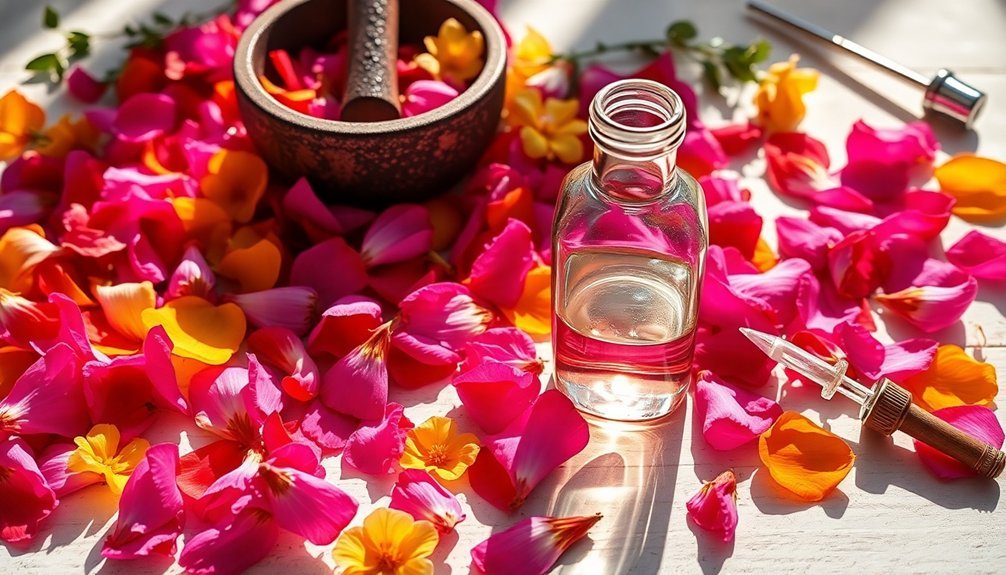
The journey from garden to bottle transforms delicate floral essences into lasting fragrances through various extraction methods.
You'll need to start by carefully chopping your selected botanicals to maximize their surface area for extraction. Whether you're using distillation for intense essential oils or gentle enfleurage for delicate blooms, each technique captures unique aromatic profiles.
For home perfumery, you can create tinctures by placing cut plant material in small glass bottles with grain alcohol. You'll want to seal them tightly and let them age for several weeks, allowing the alcohol to absorb the scent molecules.
After straining through coffee filters, you can blend different extracts to achieve your desired complexity. CO2 extraction offers the most innovative approach, preserving complex scent compositions without compromising the plant's aromatic integrity.
Preserving Delicate Floral Notes Over Time
Maintaining the integrity of delicate floral notes requires careful attention to both storage and application techniques. You'll find that higher concentrations, like Eau de Parfum, can extend your fragrance's life up to 8 hours, while proper storage in cool, dark places prevents premature degradation. When you're applying your floral scent, target pulse points and avoid rubbing, as this can break down the fragrance molecules.
| Factor | Impact | Best Practice |
|---|---|---|
| Concentration | Longevity | Choose EDP or Extrait |
| Storage | Preservation | Keep cool and dark |
| Application | Projection | Apply to pulse points |
| Climate | Performance | Humid conditions amplify |
| Ingredients | Quality | Opt for natural extracts |
Natural ingredients tend to age more gracefully than synthetics, providing consistent scent profiles throughout their lifetime. Your skin type also plays a role – oily skin typically holds fragrances longer than dry skin.
Seasonal Variations in Garden Extract Composition
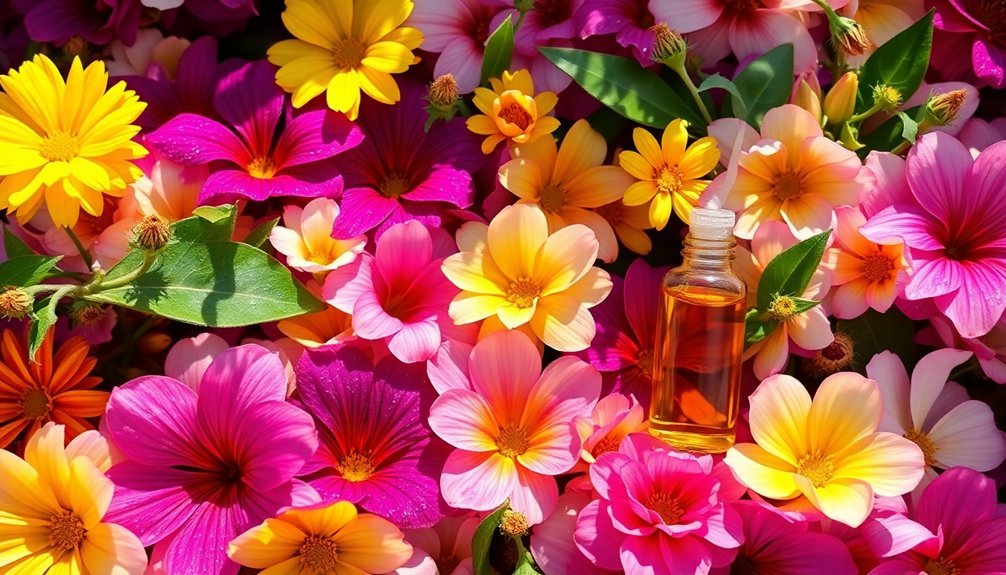
Throughout the year, garden extract compositions undergo significant chemical transformations that impact their aromatic profiles and therapeutic properties.
You'll notice that winter harvests often yield higher concentrations of polyphenolic compounds, while spring collections tend to be richer in natural pigments.
These seasonal shifts directly affect your extracts' potency and characteristics. When you're working with winter-harvested leaves, you'll typically find stronger antioxidant activity and enhanced antimicrobial properties. This is particularly evident in plants like Carissa macrocarpa, where winter extracts demonstrate superior antibacterial action compared to summer collections.
To maximize your extracts' therapeutic benefits, you'll want to time your harvests strategically. Different solvents can help you capture season-specific compounds, whether you're using methanol for winter collections or adapting your extraction method to summer's unique chemical profiles.
Harmonizing Base Notes With Floral Elements
Base notes like sandalwood and vetiver help you anchor floral elements by adding essential grounding qualities that prevent the lighter scents from dissipating too quickly.
You'll notice that woody base notes create a foundation that allows the floral components to unfold gradually, revealing their full character over time.
When you combine these deep, resonant base notes with florals, you're creating a multi-dimensional fragrance with remarkable staying power and sophisticated depth.
Grounding Florals With Woods
To create a truly memorable fragrance, floral notes need a strong foundation that only woody elements can provide. When you're developing your signature scent, consider how woody base notes like sandalwood and cedarwood can anchor delicate floral elements, ensuring your fragrance lasts throughout the day.
You'll find that woods add depth and complexity to your floral blend, transforming light, airy notes into rich, sophisticated compositions. Sandalwood's creamy warmth pairs beautifully with jasmine, while vetiver's earthy sweetness complements rose perfectly.
Creating Long-Lasting Depth
Crafting long-lasting depth in your signature scent requires mastering the delicate balance between floral elements and base notes. You'll want to combine floral middle notes with grounding base notes to achieve a harmonious and enduring fragrance.
| Floral Element | Complementary Base Note |
|---|---|
| Jasmine | Sandalwood |
| Rose | Musk |
| Lavender | Vanilla |
| Geranium | Cedar |
| Ylang Ylang | Patchouli |
The key is understanding proper ratios: use middle notes for 50-75% of your blend while keeping base notes at 5-10%. This proportion guarantees your fragrance maintains its character throughout the day. For example, you might combine 10% jasmine with 8% sandalwood to create a balanced composition that shifts smoothly from initial application to its final lingering notes.
The Science Behind Lasting Garden Fragrances
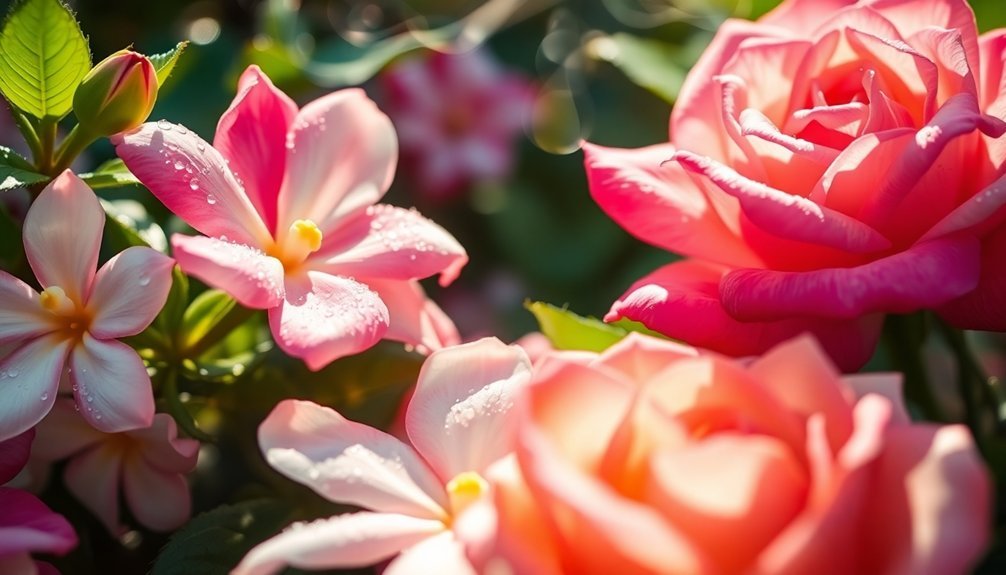
Understanding how garden fragrances persist requires an extensive exploration into their molecular composition and biological origins.
You'll find that floral scents contain complex volatile compounds, like terpenes, which vary in their evaporation rates. Heavier molecules tend to linger longer, creating that lasting impression you notice in your garden.
When flowers release these scents, they're actually sending chemical signals designed to attract pollinators. The number of scent compounds can range dramatically – from just a few in snapdragons to hundreds in orchids.
What's fascinating is how these natural fragrances interact with your own body chemistry. When you wear floral extracts, they blend with your personal pheromones to create a unique signature scent that's distinctly yours.
This biological interaction explains why the same perfume smells different on everyone.
Enhancing Scent Longevity Through Natural Fixatives
While natural floral fragrances captivate our senses, they often require fixatives to maintain their allure throughout the day. You'll find that natural fixatives like labdanum, benzoin, and patchouli work by binding with scent molecules, effectively slowing their evaporation rate and extending their presence on your skin.
| Fixative Type | Source | Primary Benefit |
|---|---|---|
| Labdanum | Rockrose Plant | Stabilizes Composition |
| Benzoin | Tree Resin | Prolongs Aroma |
| Patchouli | Essential Oil | Anchors Top Notes |
When you're creating your signature scent, consider incorporating these natural fixatives to enhance both longevity and projection. Plant-derived options like musk flowers and sandalwood not only ground your fragrance but also help create a more consistent scent experience. You'll notice that these fixatives work particularly well when applied to moisturized skin, creating a lasting impression throughout your day.
Botanical Combinations for Signature Blends
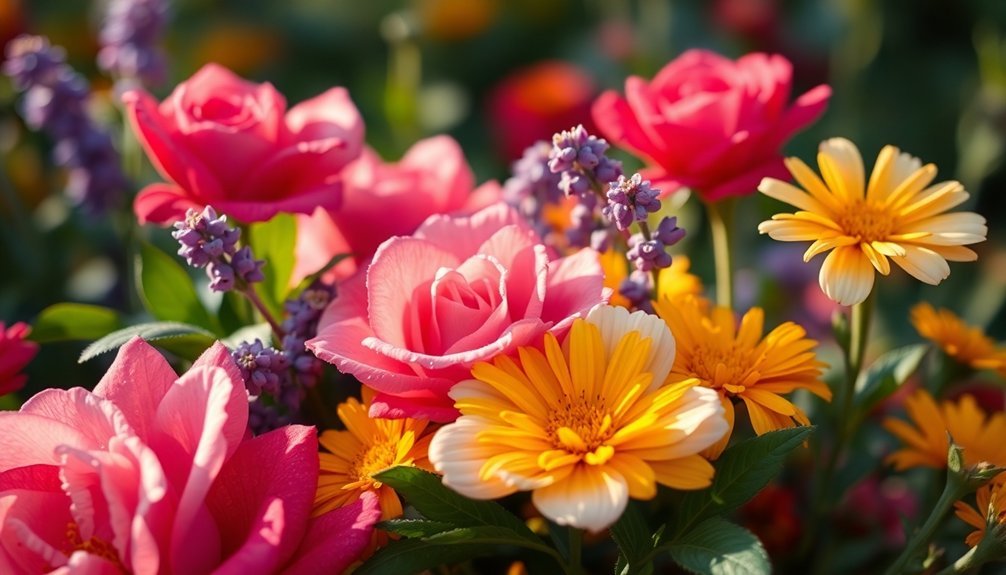
Creating your signature botanical blend starts with exploring harmonious combinations that match your desired emotional impact.
You'll find that certain scent pairings can evoke specific moods, from invigorating to calming, sophisticated to unique.
- For a fresh, energizing blend, try combining bergamot's zesty notes with earthy sage and woody juniper, or mix tropical mango with mandarin and grounding vetiver.
- When seeking relaxation, pair lavender with vanilla bliss or combine cucumber, melon, and white tea for a soothing experience.
- To achieve sophistication, blend geranium with cedar and patchouli, or create complexity by mixing cardamom and black pepper with jasmine.
The key is experimenting with these botanical combinations until you discover the perfect blend that reflects your personality and desired aromatherapy effects.
Therapeutic Properties of Garden Extracts
Natural garden extracts offer a remarkable array of therapeutic benefits that extend far beyond their pleasant aromas.
You'll find potent healing properties in common flowers like chamomile, which tackles everything from skin inflammation to digestive issues while calming your nerves.
Purple coneflower strengthens your immune system and fights respiratory infections, while calendula's antibacterial properties make it ideal for wound healing and skin care.
If you're looking to address hormonal balance, consider borage for managing menopausal symptoms or angelica for digestive comfort.
Marigold improves your circulation while detoxifying your system, and Chinese juniper helps with respiratory discomfort and kidney health.
These botanical extracts don't just smell wonderful – they're nature's medicine cabinet, offering targeted solutions for your respiratory, digestive, skin, and hormonal health needs.
Environmental Factors Affecting Scent Development

Modern environmental challenges pose significant threats to the delicate process of floral scent development.
You'll notice these impacts through reduced scent intensity and altered fragrance compositions in your garden. Climate change has advanced flowering times by four weeks, disrupting the natural synchrony between plants and their pollinators.
Three critical environmental factors affecting your garden's scent production:
- Drought conditions diminish both the volume and intensity of volatile organic compounds.
- Air pollutants, especially diesel fumes, interfere with pollinator attraction, reducing visiting insects by 70%.
- Seasonal shifts alter the timing of scent emission, affecting pollinator relationships that evolved over millennia.
These changes don't just impact your garden's fragrance – they're reshaping entire ecosystems, as specialist pollinators struggle to adapt to new scent patterns and flowering times.
Frequently Asked Questions
How Do Extinct Flower Fragrances Compare to Their Modern Recreations?
You'll notice extinct flower fragrances can't be perfectly matched to modern recreations since they're based on DNA interpretation and creative speculation. While scientifically innovative, today's versions are educated approximations of historical scents.
Can Personal Body Chemistry Affect How Garden Extracts Develop Over Time?
Yes, your unique body chemistry dramatically affects how garden extracts develop. Your skin's pH, oils, pheromones, and diet all interact with floral molecules, creating a personalized scent that evolves throughout the day.
What Role Do Synthetic Enhancers Play in Natural Floral Extract Blends?
You'll find synthetic enhancers act as stabilizers and amplifiers in floral extracts, helping to intensify natural scents, extend their longevity, and create consistency across batches while maintaining the blend's authentic botanical character.
How Do Cultural Differences Influence Preferences for Specific Garden-Based Scents?
You'll notice cultural preferences vary widely – Mediterranean cultures favor citrus-herb blends, Asian cultures prefer complex jasmine notes, while Middle Eastern regions embrace strong floral scents. Your local climate shapes these choices too.
Why Do Some People Experience Headaches From Certain Floral Extracts?
You'll get headaches from floral extracts when their volatile chemicals trigger your trigeminal nerve pathway, causing inflammation and vasodilation. These compounds can also stimulate allergic responses and heighten your sensitivity to smells.
In Summary
You'll find that garden-inspired fragrances offer endless possibilities for creating your signature scent. By understanding extraction methods, mastering botanical layering, and selecting natural fixatives, you're able to develop complex, long-lasting aromas that capture nature's essence. Whether you're drawn to delicate florals or rich herbaceous notes, you can craft personalized fragrances that reflect both tradition and innovation in botanical perfumery.
References
- https://www.sangredefruta.com/pages/signature-scents
- https://www.sweetstudy.com/files/awritersreference.pdf
- https://www.sunset.com/lifestyle/future-society-perfumes-extinct-flowers
- https://mhs.milfordk12.org/ourpages/auto/2020/1/15/12784324316041332238/294751235.pdf
- https://www.caswellmassey.com/pages/nybg
- https://sedonaaromatics.com/history-of-the-aromatic-garden/
- http://travelinggardener.com/Tg/Articles/Entries/2011/6/1_Garden_of_Fragrance.html
- https://the-history-avenue.eu/2024/03/24/scent-and-sensibility-fragrance-in-18th-century-garden-culture/
- https://entanglementsjournal.wordpress.com/natural-scents-cultural-perfumes-revelations-floral-fragrances/
- https://en.chateauversailles.fr/sites/default/files/presse/documents/the_perfumers_garden_press_release.pdf
- https://gyalabs.com/blogs/diy-recipes/floral-essential-oils-blend-recipes
- https://achs.edu/blog/blending-101-the-art-of-pairing/
- https://nyc.ph/blogs/inspiration/the-power-of-floral-scents-how-they-impact-the-science-of-attraction
- https://prosodylondon.com/blogs/news/5-best-flower-perfume-extraction-methods/
- https://armafperfume.com/blogs/blogs/the-science-of-fragrance-blending-creating-perfect-scents
- https://mockingbirdapothecary.com/blogs/mockingbird-blog/crafting-perfect-scents-an-essential-oils-blending-guide-for-beginners
- https://www.soapguild.org/tools-and-resources/resource-center/73/beginners-guide-to-fragrance-blending/
- https://www.customprocessingservices.com/blog/top-4-ways-to-extract-essential-oils-from-plants
- http://naturalezacienciaysociedad.org/wp-content/uploads/sites/3/2016/02/Tsing-Anna-Lowenhaupt-The-mushroom-at-the-end-of-the-world-on-the-possibility-of-life-in-capitalist-ruins-Princeton-University-Press-2015.pdf
- https://www.edenbotanicals.com/extraction-methods





Leave a Reply